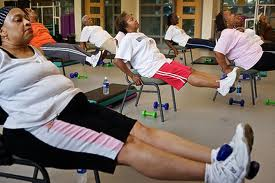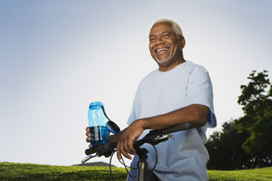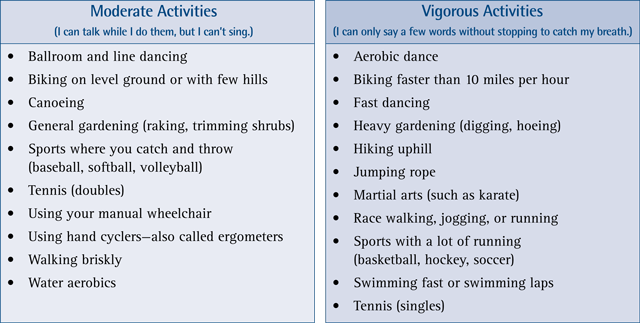Topics
Additional health advice:
Becoming More Active: Safely Meeting the Physical Activity Guidelines
Physical activity is defined as anything that gets your body moving. According to the 2008 Physical Activity Guidelines for Americans, you need to do two types of physical activity each week to improve your health–aerobic and muscle strengthening. CLICK HERE for a reminder about how much is recommended. Engaging in different forms of physical activity is important to overall physical and mental health. One of the most rewarding parts about increasing your current activity level is noticing the difference it makes in the rest of your life. Even if you begin with a few simple stretches while seated or a short walk around the block, you will begin to notice an improvement in how you feel as you go about your day.
 To enjoy the benefits of physical activity, you don’t need to devote hours of your day or train at the gym. If you are currently inactive or seldom active, start out at a level you feel comfortable with and gradually increase to meet the recommendations. For instance, you may want to start out with a 15 minute walk a few times a week and build up to 30 minute walks, 5 days a week. Like the best things in life, becoming more active can be completely free by using common items and resources. No weights? Use soup cans or water bottles – or CLICK HERE to download a strength training routine you can try today.
To enjoy the benefits of physical activity, you don’t need to devote hours of your day or train at the gym. If you are currently inactive or seldom active, start out at a level you feel comfortable with and gradually increase to meet the recommendations. For instance, you may want to start out with a 15 minute walk a few times a week and build up to 30 minute walks, 5 days a week. Like the best things in life, becoming more active can be completely free by using common items and resources. No weights? Use soup cans or water bottles – or CLICK HERE to download a strength training routine you can try today.
The Go4Life Guide is a great resource to help you fit more physical activity into your daily life. To find out more about how Go4Life can help you be more active, visit their website at www.nia.nih.gov/Go4Life.
If you have not tried to be active for a long time, keep in mind the following general health precautions:
- Get medical clearance - If you have special health issues such as an existing heart condition or high blood pressure, talk with your doctor and let him or her know your plans
 Stretch - No matter what form of physical activity you choose, you will benefit from adding stretching exercises to gain flexibility and range of motion. It is best to walk and loosen up a bit before stretching though so your muscles aren't tight. Stretching during your cool down is a great form of injury-prevention.
Stretch - No matter what form of physical activity you choose, you will benefit from adding stretching exercises to gain flexibility and range of motion. It is best to walk and loosen up a bit before stretching though so your muscles aren't tight. Stretching during your cool down is a great form of injury-prevention. - Drink plenty of water- Your body performs best when it's properly hydrated. Failing to drink enough water when you are exerting yourself over a prolonged period of time, especially in hot conditions, can be dangerous.
Knowing the intensity level of your physical activity is also important! The intensity level of physical activity refers to the rate at which the activity is being performed. It is often characterized as “how hard a person has to work to perform a given activity.” The intensity depends on many factors, such as the type of activity performed, an individual’s fitness level, or an individual’s previous experience with the activity. Current physical activity guidelines for children, adults and older adults are to perform moderate-to-vigorous intensity physical activity.
Know your intensity! The table below, from Be Active Your Way. A Guide for Adults, helps you to understand the difference between moderate and vigorous activities.
How can I tell an activity at a moderate level from a vigorous one?
Vigorous activities take more effort than moderate ones. Here are just a few moderate and vigorous aerobic physical activities. Do these for 10 minutes or more at a time.

There are two basic ways to measure your physical activity intensity:
- How you feel. One way to gauge the intensity of your activity is to rate how hard you feel like your body is working - this is called your perceived exertion. How hard you feel an activity is may be different from someone else’s perception. For example, what feels like an easy walk up the hill to you can feel like more strenuous physical activity to someone who is less fit. Try to monitor how you feel during your physical activity. To learn more ratings of perceived exertion: http://www.cdc.gov/physicalactivity/everyone/measuring/exertion.html.
- Your heart rate. Your heart rate is a more objective measure of your physical activity intensity. As a general rule, the higher your heart rate during physical activity, the higher the intensity level of your physical activity. Monitor your heart rate before, during, and after you are physically active. To learn more about how to measure your heart rate and your target heart rate: http://www.cdc.gov/physicalactivity/everyone/measuring/heartrate.html.